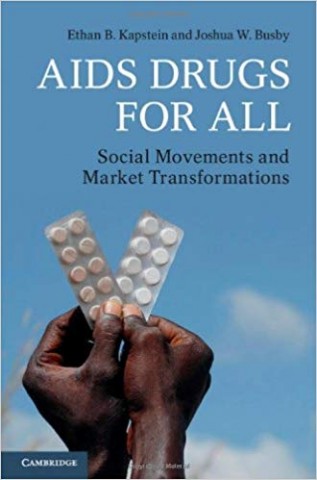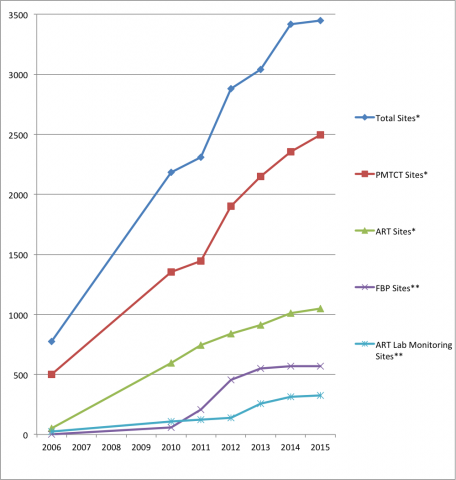In the 1990s and into the 2000s, there were effective treatments for AIDS, yet the poorest countries and people did not have access to them. How did the global transformation come about whereby treatments became more readily available, and in most countries in the Global South free? Kapstein and Busby outline how this transformation took place in "AIDS Drugs for All: Social Movements and Market Transformations" (2013). This is an excellent resource, and provides insight on 'how change happens' well beyond HIV / AIDS and health. For anyone interested in social movements, and particularly social movements that seek to change that involves markets, this is essential reading.
The authors state that their book is "about market transformations, or efforts by social movements to change global market processes and their distributive effects. Our main case study is drawn from the pharmaceutical industry, and, more narrowly, we examine how social activists and police entrepreneurs in the public and private sectors (whom we collectively refer to as "advocates") decisively shaped the market for the antiretroviral drugs (ARVs) that are used to combat HIV/AIDS" (p. vii). Why the need for the book? There are diverse narratives about why this change came about: "economists have generally argued that what brought down the price of ARVs around the world was entry by low-cost generic producers, just as these producers have driven prices down on many medications that are now on offer (see, e.g., Hellerstein 2004). In this version of events, the market acts "naturally" or "spontaneously," with new entrants forcing competition upon the incumbent firms. What this perspective overlooks, however, is that the groundwork for generic entry was laid by advocates who sought to show in the first instance that ARV delivery in the developing world was effective and who then helped to pool demand in order to create a market sizable enough to be of commercial interest. Finally, they helped spur industrialized world governments to increase foreign aid funds that were earmarked for AIDS treatment, so that developing world governments could acquire the drugs at these reduced prices. Generic drugs, in short, did not "drop by parachute" into the developing world; their entry was catalyzed by advocates, that at a minimum helped save many lives by speeding drug delivery" (p. viii).
Kapstein and Busby assess these changes with "a theory of strategic moral action" which they apply to a range of other issues. Their theory "argues that market transformations in the case of ARVs required the following: first, a market structure or favorable set of underlying economic and industrial conditions that provided opportunities or openings for an advocacy movement; second, the elaboration by the AIDS movement of a compelling frame that pitting drug company profits against global access to live-saving ARV medications; third, a political and organizational consensus or coherent "ask" on the part of the social movement that treatment should receive the highest policy priority, trumping, for example, preventing; fourth, a feasible strategy (defined in this case as one that minimized the costs of market transformation to the major players) for how a universal access to treatment market could be made to operate; finally, a set of institutional arrangements to help set the rules for the transformed market and to stabilize its operations." (p ix-x)
A tactic familiar to organizations like Oxfam, the authors argue that in "order to contest the market, however, one must first "deconstruct" is in order to identify its moving parts and target its points of weakness" (p. 10). One their point of entry is identified, the demand must be clear, consistent and coherent: "If transnational social movements are to be successful in shaping the political and economic agendas of governments and firms, they must fuse both rational / analytical and emotional / normative appeals into a single "ask"" (p. 14). Further: "Moral arguments that are diffuse do not succeed; they need focus and organization for collective action. But these are insufficient as well; they also need a feasible strategy that relates means and ends. What this suggests is that to be successful or effective, social movements also need a compelling business strategy, a feasible model of how to get from point A to point B." (p. 22) In the struggle for AIDS treatment it was not just a business case but also showing that treatment was feasible around the world: "Showing that rollout was possible in the setting of "resource constrained" economies was therefore critical to the process of getting these firms to the negotiating table" (p. 137).
They conclude: "It is our hope and belief that the AIDS example provides lessons for other advocacy movements in terms of what it takes to make a fundamental shift in market logic possible. We have been motivated to extend our argument by the many other challenges that the world now faces, including climate change, modern slavery and sex trafficking, and a host of other deadly diseases that particularly afflict women, children, and other vulnerable groups. If advocates are to help bring about market transformations, they must overcome a successive set of hurdles. These include the need to understand the market structures they face, the development of a compelling frame and coherent ask, a feasible cost-benefit strategy, and a set of institutions to stabilize any new market arrangements." (p. 276)


